Homemade pickles are a gardener’s staple. If you’re notb already growing garlic, dill and cucumbers in the garden, then let this be your exhortation to do so, STAT! Then use this recipe for refrigerator pickles (it’s the best dill pickle recipe I know of), or can them to be shelf-stable and last all year long.
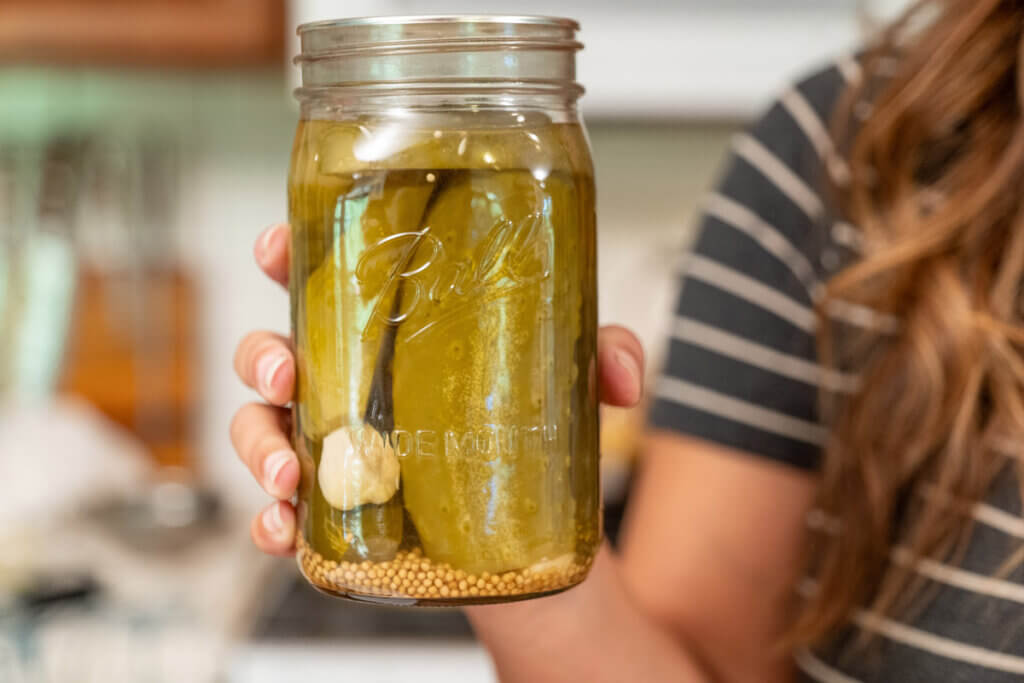
When it comes to canning homemade pickles, the number one complaint I hear from people is that their pickles end up soggy! And no one likes a soggy pickle!
That’s why so many people revert to refrigerator pickles. The great news is with this recipe, you can make crispy cukes that are perfect for a charcuterie board appetizer, to slice for sandwiches, or straight out of the jar.
Just skip the canning process and place your pickles in the refrigerator for at least a week before eating (though the flavor will be best after two weeks if you can wait that long!). I use this method to preserve when it’s too hot to can!
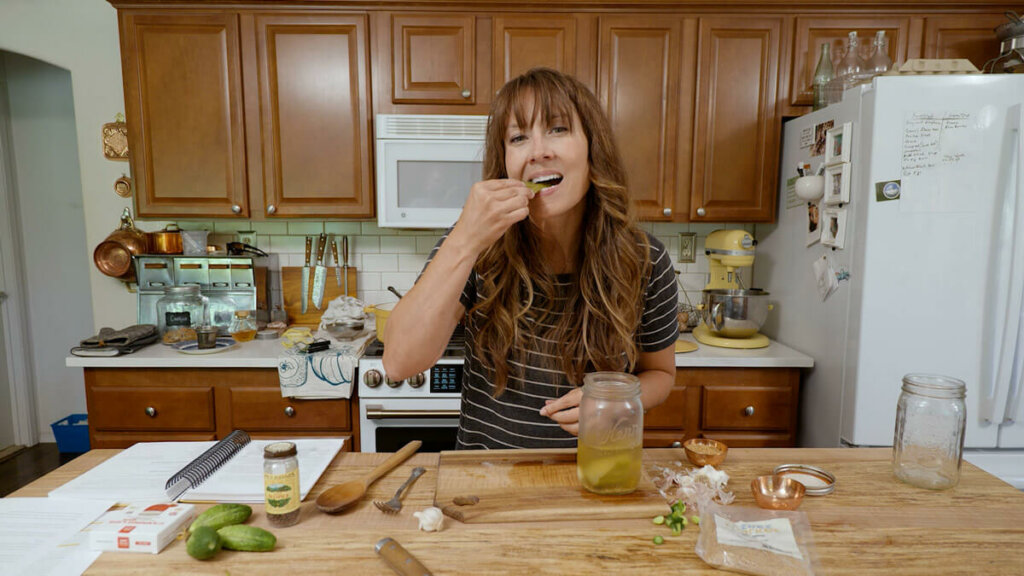
Table of Contents[Hide][Show]
- Why I Love This Recipe
- Refrigerator Pickles vs. Canned Pickles
- Tips for the Best Pickles (That Stay Crunchy)
- Supplies Needed
- Ingredients Needed
- Melissa’s Pickling Spice
- Everything Worth Preserving
- How to Can Pickles
- How Long Will Canned Pickles Last?
- Pickle Making Tips & Tricks
- More Posts You Might Enjoy
- Best Homemade Pickles Recipe (Garlic Dill Pickles)
Why I Love This Recipe
When you grow, harvest and preserve ingredients that started as seeds in your garden, there’s this incredible sense of satisfaction. Even if you’re purchasing the herbs and spices, or even buying cucumbers in bulk from your local farmer’s market to can your homemade pickles for the year, there’s great joy in knowing every ingredient that goes into your food.
And who doesn’t love looking at a pantry shelf lined with home-canned food?
These pickles are the perfect combination of dill and garlic. They’re crunchy and tangy and make the best snack straight out of the jar, or slice them up to top your favorite sandwich.
I’m a pickle fanatic, there’s a reason why I have so many pickle recipes on the website! You’ll want to make them all:
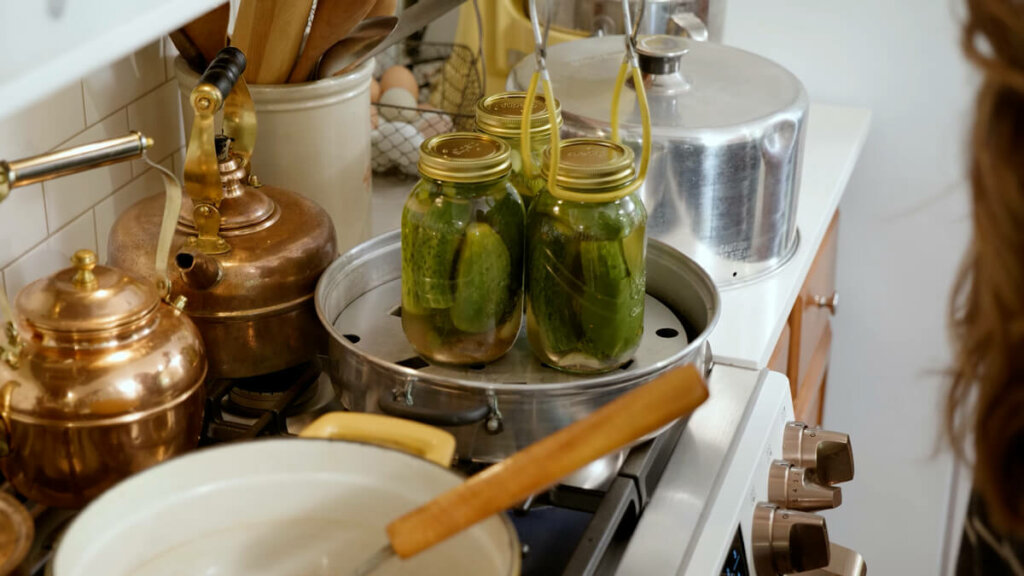
Refrigerator Pickles vs. Canned Pickles
Though I love a good quick refrigerator pickle, I don’t have enough refrigerator space to put up enough for the entire year. So we make this canned pickle recipe with the majority of the cucumber harvest.
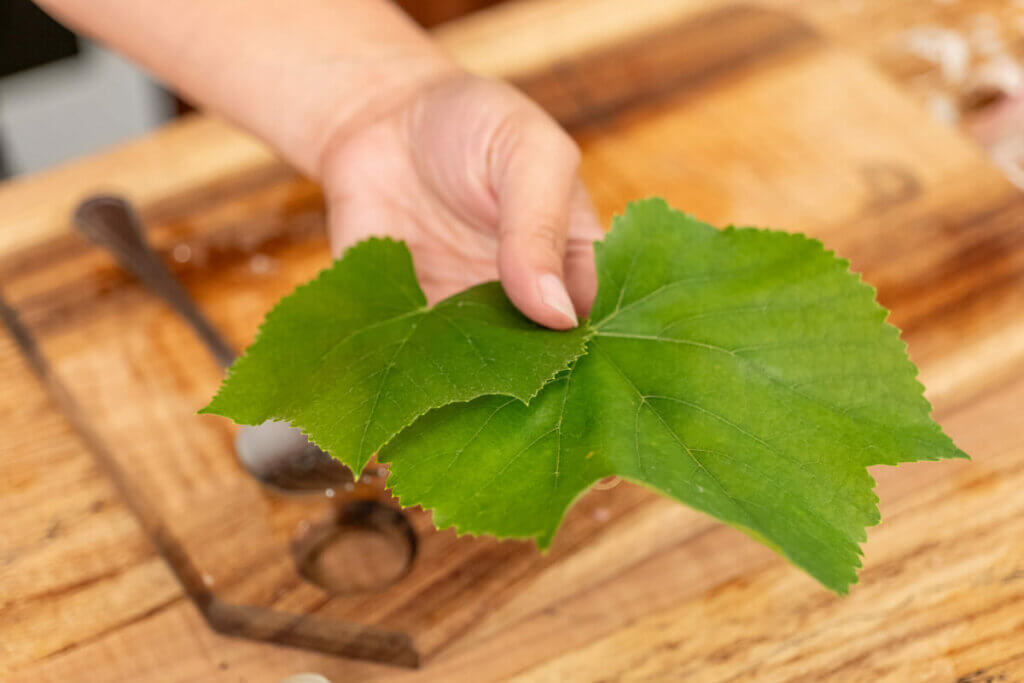
Subscribe to Melissa K. Norris!
Get updates on the latest posts and more from Melissa K. Norris straight to your inbox.
We use your personal data for interest-based advertising, as outlined in our Privacy Notice.
Tips for the Best Pickles (That Stay Crunchy)
There are a few tips to remember when making this homemade garlic dill pickles recipe, especially if you want to avoid soggy pickles!
In fact, I have an entire post on seven tips for the crunchiest pickles. If this is your first time making pickles, I highly recommend reading that post for more tips.
When making pickles, it’s important to…
- Pick cucumbers in the morning. Cucumbers will be their firmest in the early morning. Try to avoid harvesting cucumbers in the afternoon when their water content is the lowest.
- Pick cucumbers when they’re ripe. If your cucumbers grow too large, they can get bitter or have off flavors. Pick cucumbers when they still have their prickly spines and are light to dark green in color. A cucumber is over-ripe when it turns pale yellow, loses its spines and gets bloated.
- Use a good pickling variety of cucumbers. There are countless varieties of cucumbers available to grow in the garden, but not all cucumbers make good pickling cucumbers. Choose a variety that’s known for pickling.
- Preserve them as soon as possible after harvesting. If you harvest cucumbers and let them sit at room temperature, they tend to get soft. Once a cucumber has gone soft, it won’t ever firm up again. So preserve them straight away, or put them in salt and ice water in the refrigerator if you don’t have enough to merit canning a batch.
- Remove the blossom end. The blossom end contains enzymes that can cause soggy pickles. If the stem and blossom are both already removed and you’re not sure which end is the blossom end, look for the end that’s lighter green (watch the video for an example).
- Use an ice water/salt-water bath prior to canning. The ice water and salt help keep the pickles firm. The salt will actually help draw out excess moisture in the cucumber, which will result in a crispier pickle. You can soak cucumbers for up to three days in the refrigerator and add more as you harvest. Allow them to soak for a minimum of 12 hours.
- Can cucumbers whole. I love a good pickle spear or sliced pickle, however, I’ve noticed that my pickles will stay much more crisp when canned in their whole form. So if I want pickle spears or slices, I’ll just slice it at the time of eating.
- Add tannins! Tannins will also help keep pickles crunchy during the canning process. See the options for tannins in the ingredients needed section below (Grape Leaves or Black Tea).
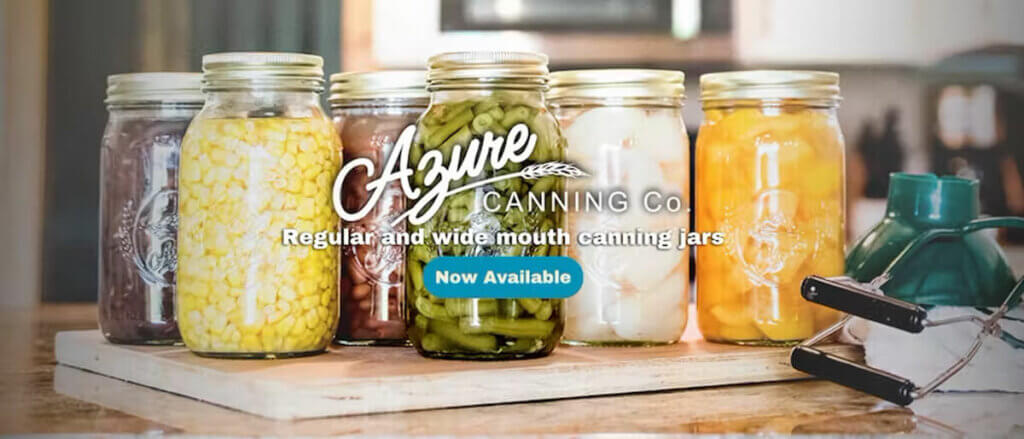
Supplies Needed
- Canning Jars & Lids – My new favorite source for canning jars is Azure Standard. In 2023 they released their new canning line, “Azure Canning Co,” and they sell regular and wide-mouth canning jars. I recommend using wide-mouth canning jars for pickles because they’re easier to get in and out of the jars. However, as you can see in this post, regular mouth canning jars also work. Azure Standard sponsored this post! Right now you can get 10% off your first Azure Standard order of $50 or more by using coupon code “Melissa10” at checkout.
- Water Bath or Steam Canner – I have fallen in love with my steam canner and prefer to use it over my water bath canner for all my water bath canning recipes. But use what you have and what you’re comfortable with.
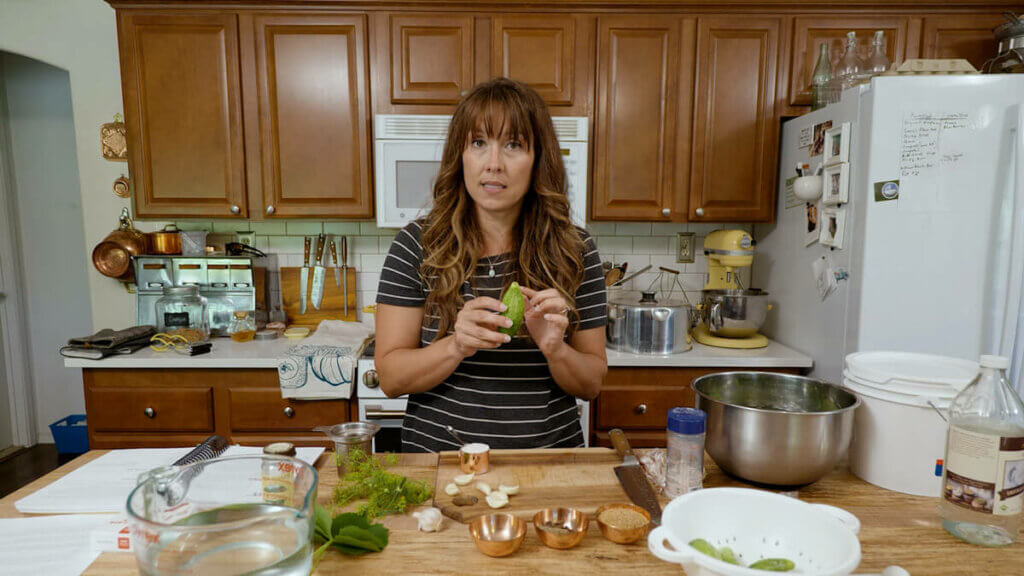
Ingredients Needed
- Vinegar – Make sure you’re using vinegar that’s at least 5% acidity. Some vinegar on the grocery store shelves is only 4%, which is not approved for safe canning. Botulism cannot survive in an acidic environment, so we need to be sure our canning recipes are safe and approved. I buy my organic (non-GMO) white vinegar from Azure Standard. Though any vinegar can be used (some people love the flavor of apple cider vinegar), white vinegar will keep the brine nice and clear and give you that classic dill pickle flavor.
- Water – If you find a canning recipe that doesn’t call for at least equal parts water to vinegar, then it’s likely an old canning recipe.
- Salt – Anytime I’m using salt on the homestead, you know it’s going to be Redmond’s Real Salt (get 15% off your order by using coupon code “Pioneering” at checkout). You may notice a pinkish-red sediment at the bottom of your jars of pickles, and this is completely normal and harmless. You can also use kosher salt or pickling salt.
- Sugar – Sugar is optional. Most people like to add a bit of sugar to cut down on the pucker factor of the pickles. However, it’s not included for any canning safety reasons, so you can omit it if you prefer.
- Pickling Spices – Much of the flavor is going to come from your pickling spices. There’s no “right” or “wrong” pickling spice, but the one I love the most is homemade and has celery seed, whole allspice and whole peppercorn (recipe below). Pro Tip: Use a tea infuser for your pickling spices so you don’t have to strain the brine!
- Garlic – I like to do two smashed garlic cloves per quart jar (or one clove for pint jars). Feel free to adjust this ratio to your liking (you know I’m adding a couple extra cloves garlic!).
- Whole Mustard Seed – I use two teaspoons per quart (or one teaspoon per pint). Again, adjust to your liking.
- Grape Leaves (or Black Tea) – The tannins found in grape leaves, black tea, oak leaves or horseradish leaves will help keep the pickles crunchy (some people use bay leaves, though this may add a unique flavor to your pickles). Add one leaf per jar, or add 4 teaspoons of loose leaf black tea to your brine (strain before filling jars).
- Dill – You can use sprigs of fresh dill heads, dried dill seeds or chopped fresh dill weed for this recipe. If using fresh dill heads, I like to use two or three heads per quart jar. If using dried dill seed or chopped fresh dill weed, use 2 Tablespoons per quart jar (1 Tablespoon per pint jar).
- Cucumbers – Be sure to use a good pickling variety of cucumbers (persian or kirby cucumbers are some popular choices). Also, make sure your cucumber is firm. No amount of ice water baths or canning will make a soggy pickle firm. So starting with good firm cucumbers is key.
- Red Pepper Flakes (optional) – If you like your homemade garlic dill pickles recipe to have a bit of a kick, you can always add a 1/4 teaspoon of red pepper flakes to each jar.
Melissa’s Pickling Spice
No pickling spice, no problem! Simply combine the following ingredients, and you’ll have your own homemade pickling spice anytime you need it:
- 1 Tablespoon Celery Seed
- ½ Tablespoon Whole Black Peppercorns
- ½ Tablespoon Allspice
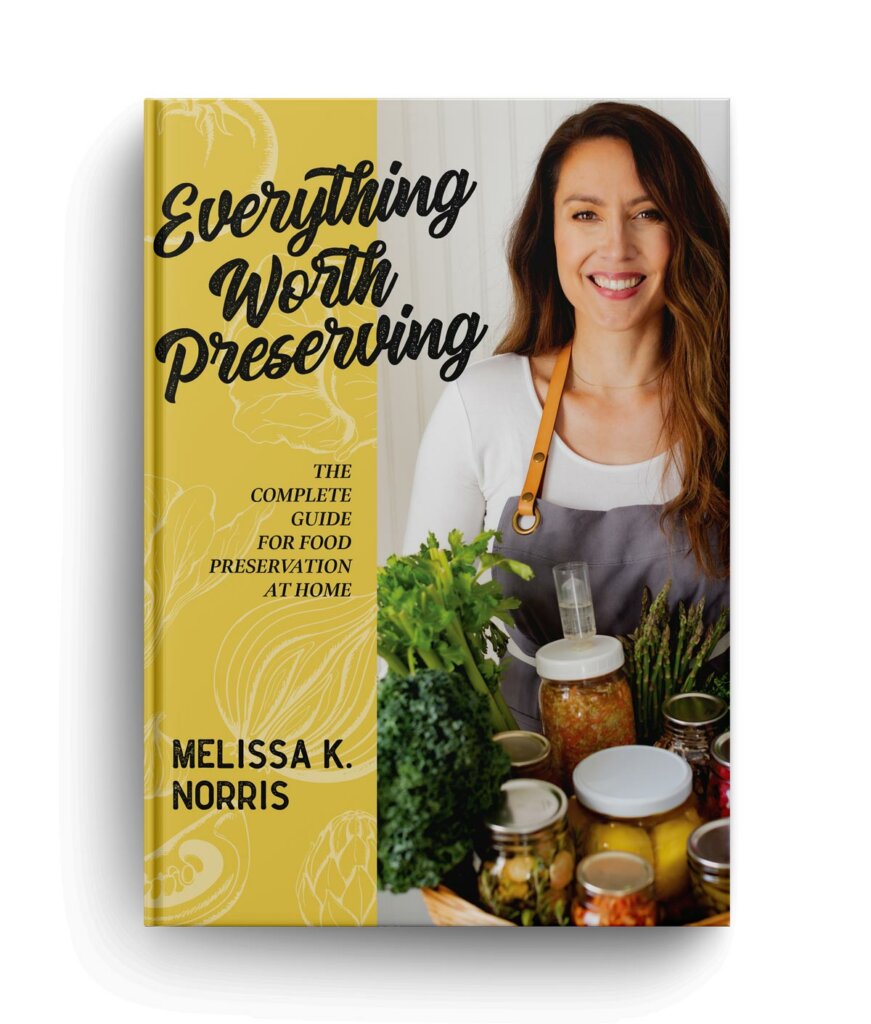
Everything Worth Preserving
This homemade garlic dill pickles recipe can be found on page 206 of my cookbook Everything Worth Preserving.
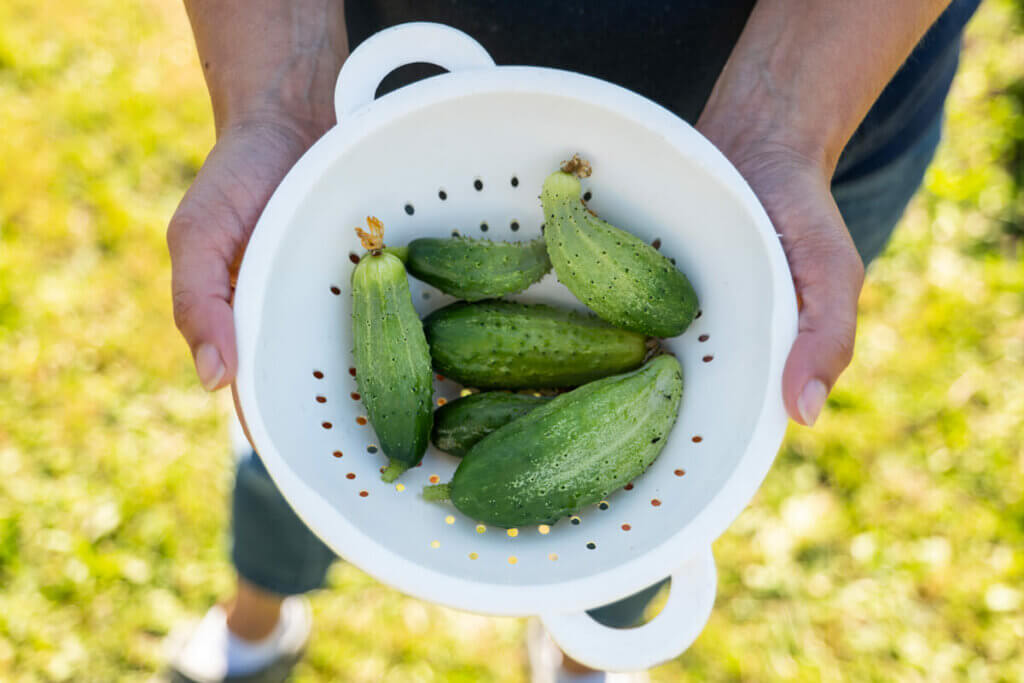
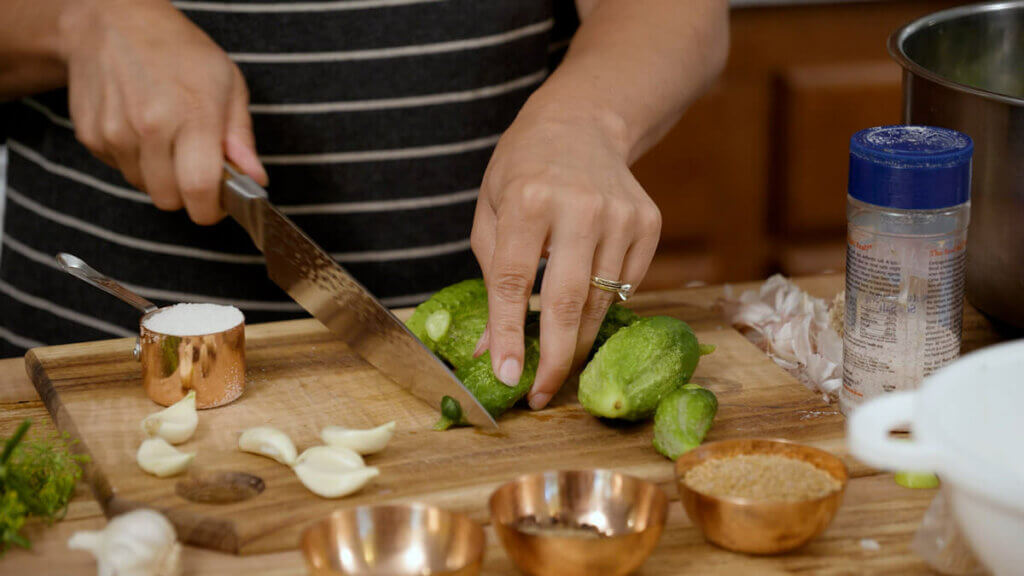
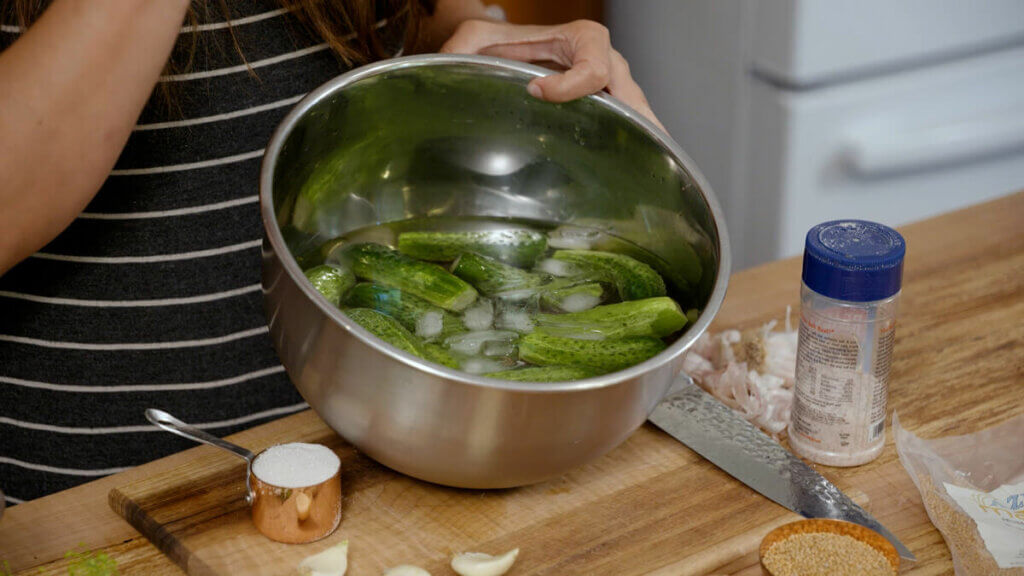
How to Can Pickles
- Wash cucumbers well in cold water; gently scrub off any dirt. Remove ¼ inch from the blossom end of the cucumber. Place all of your cucumbers in a large glass or stainless-steel bowl. If more than a few layers deep of cucumbers, layer ice between the layers of cucumbers. If it’s a smaller amount, place ice on top of cucumbers.
- Mix ½ cup of pickling/canning salt with 4 cups of cold water (double this as needed if doing a larger batch of pickles). Pour over top of cucumbers, adding more cold water if necessary to cover the tops of the cucumbers. Use a clean plate and place on top of the cucumbers to keep them under the surface of the ice salt water. Fill a pint-sized Mason jar with water (use a lid) and set it on top of the plate to act as a weight. Put the bowl in the fridge overnight or for 12 hours.
- After soaking cucumbers, pour off salt water and rinse thoroughly with cold water and allow cucumbers to drain.
- While cucumbers are draining, begin heating up the water in your water-bath canner (or steam canner). Place brine ingredients in a large stainless-steel pot and bring to a low boil; stir to dissolve the sugar and salt. Allow to simmer for about 10 to 15 minutes or until the spices have been seeped into and flavored the brine. Once you have boiling water in your canner, turn the heat to low and keep just below a simmer.
- Wash and rinse jars in soapy hot water (no need to sterilize them). Place garlic, mustard seed and a grape leaf in each jar. I prefer to use a wide-mouth when making pickles. Using the larger cucumbers first, pack your jars, tucking the smaller cucumbers up around the top to a generous 1-inch headspace. Add your dill heads, slipping them down around the cucumbers.
- Remove your spices from the brine and pour the hot brine over the cucumbers to ½-inch headspace. Remove air bubbles and recheck your headspace. Add more brine if needed. Wipe the rims clean and put the lids and bands on, then screw down to fingertip tight. (Learn what fingertip tight looks like here.)
- Place prepared jars into a water-bath or steam canner. Process quart jars for 15 minutes and pints for 10 minutes.
- After the processing time, turn off the heat and remove the lid of your water bath canner. Let your jars sit for five minutes before removing them from the canner. (If using a steam canner, turn off the heat and leave the lid on for five minutes before removing the lid and proceeding to the next step.)
- Place jars on a towel-lined counter and let sit for 12-24 hours, undisturbed.
- Check the seals of the jars, remove the bands, and wipe any residue from the jar with a damp towel.
- Finally, label each jar with the contents and the date and store in a single layer on the pantry shelf.
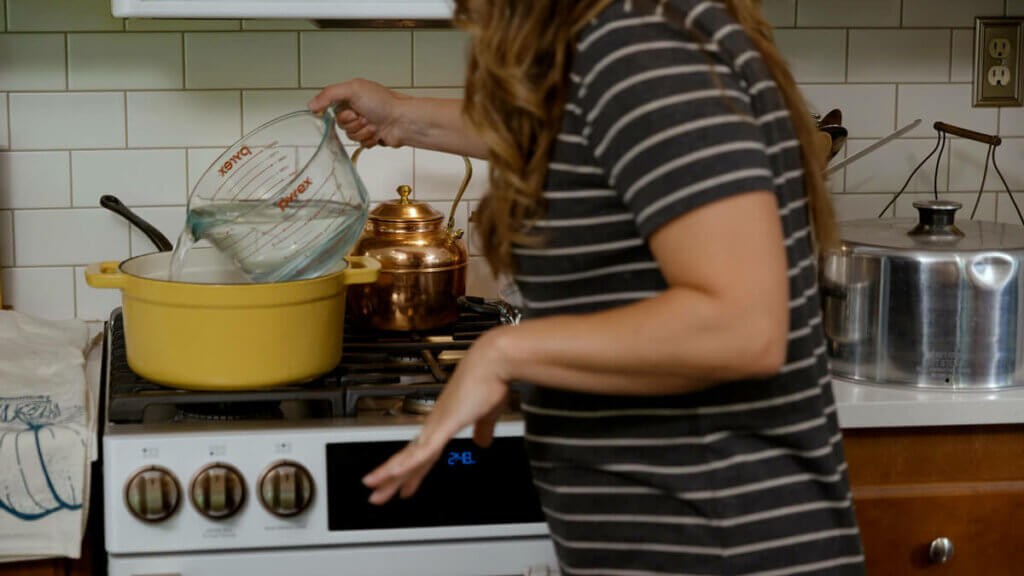
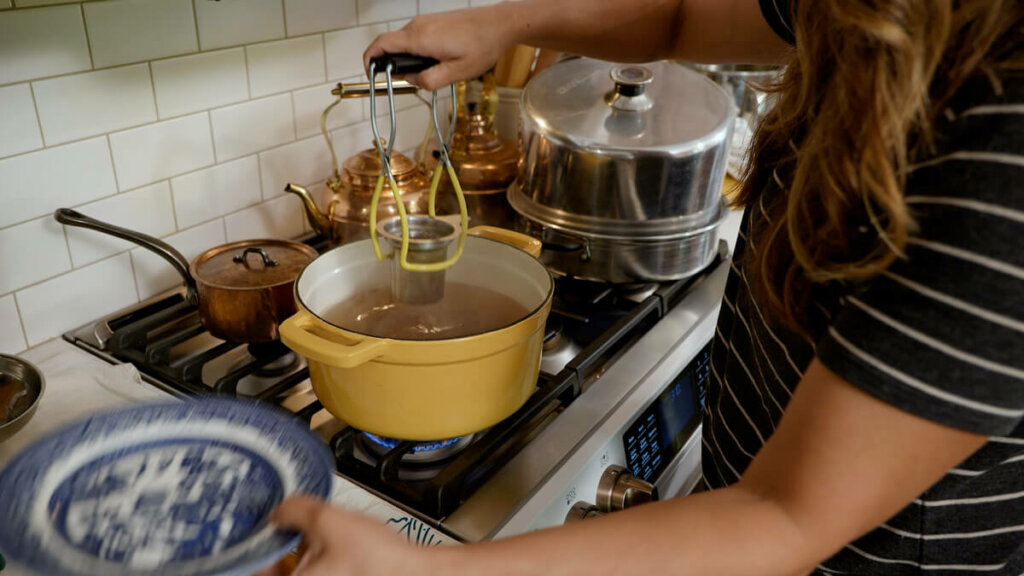
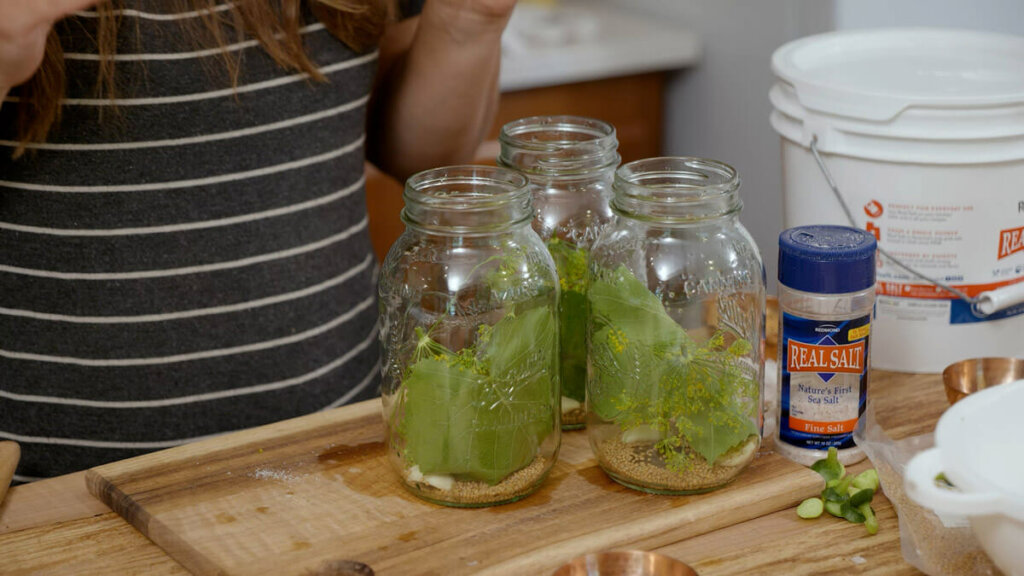
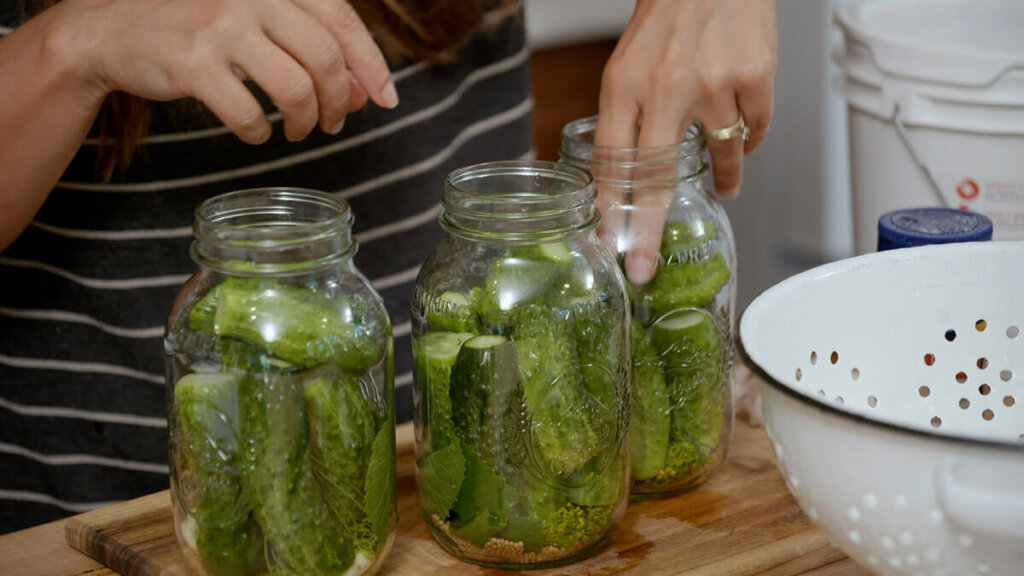
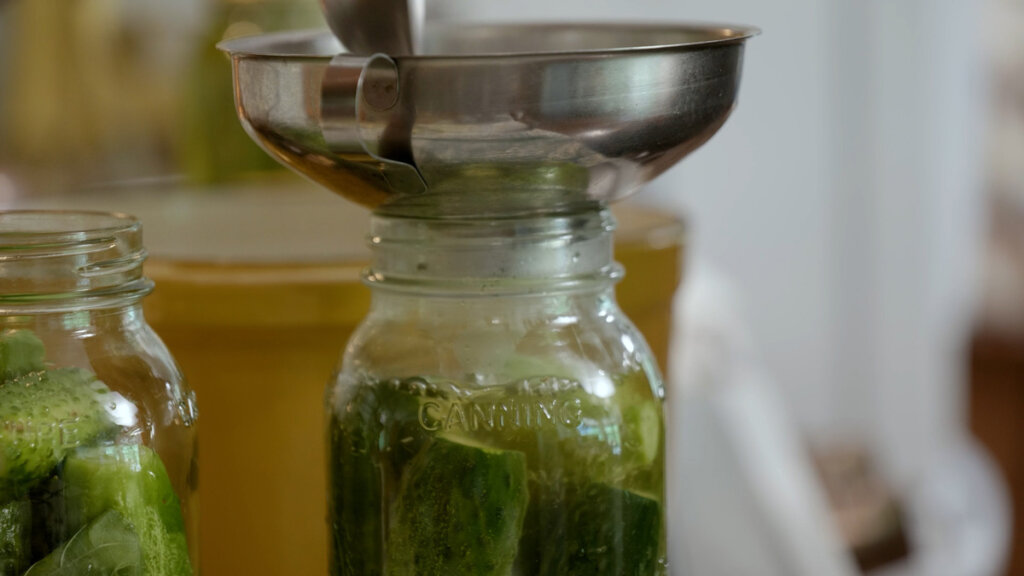
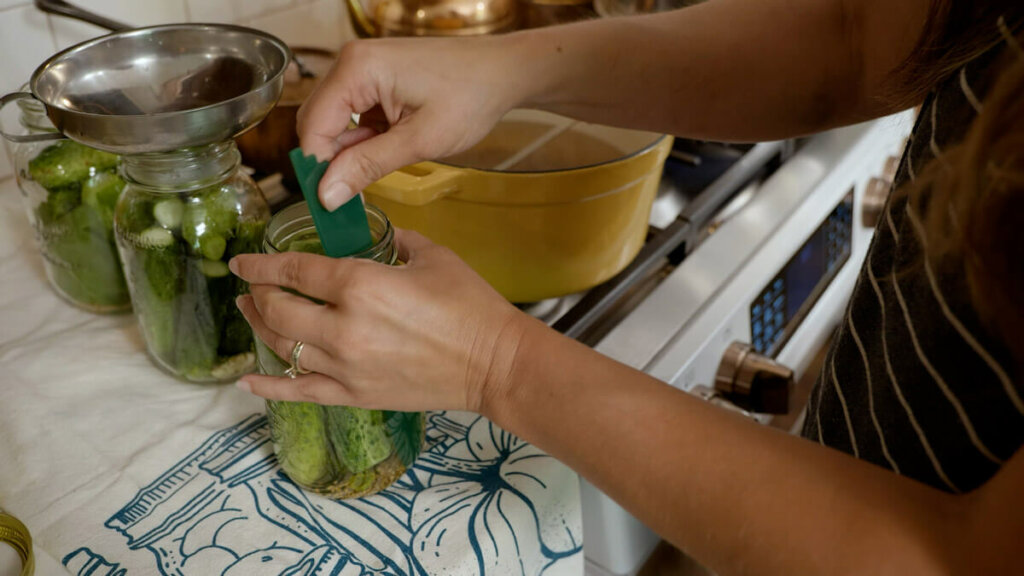
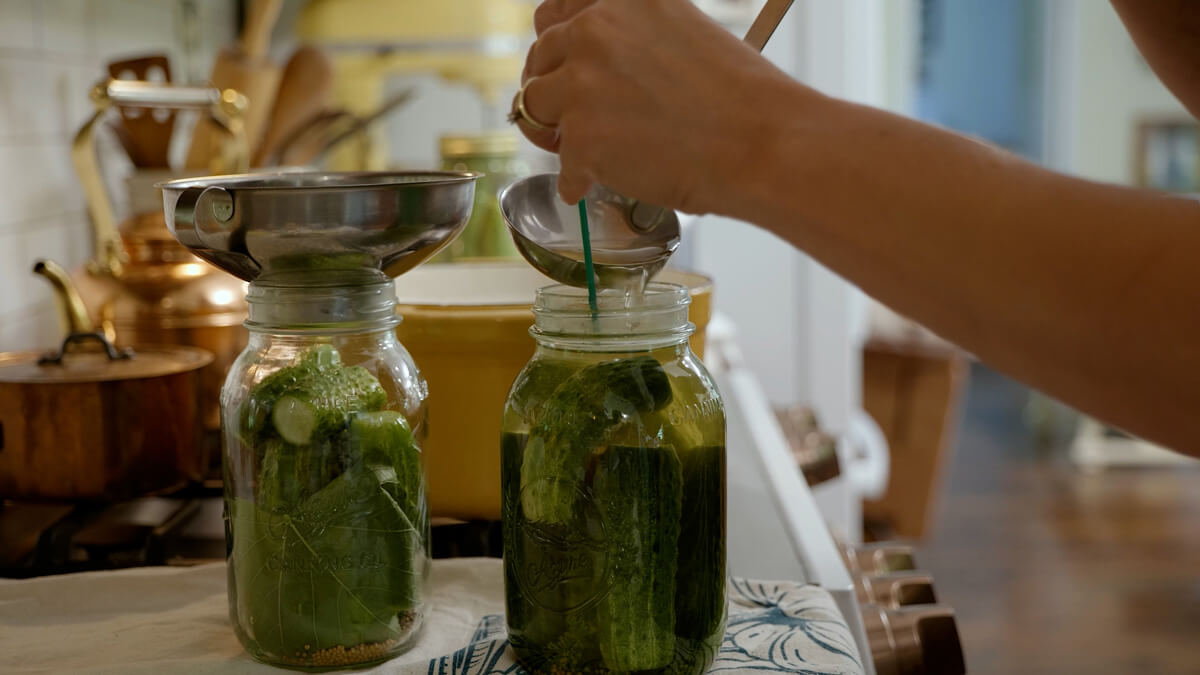
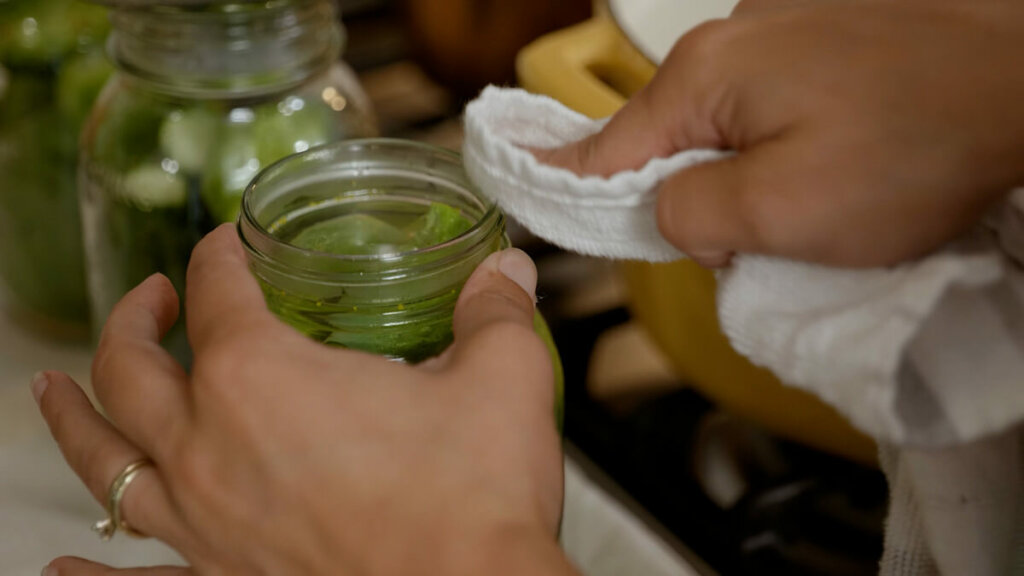
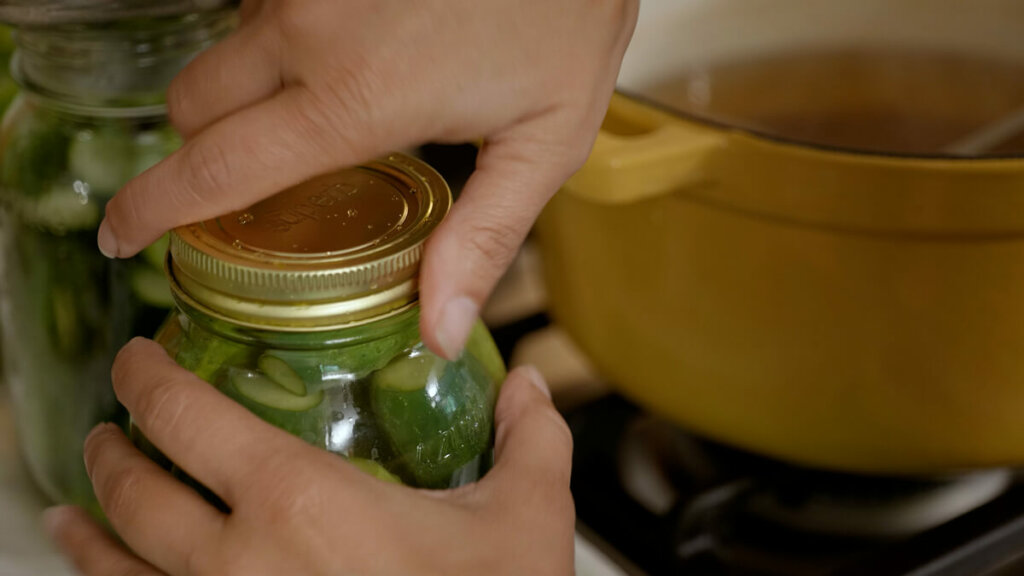

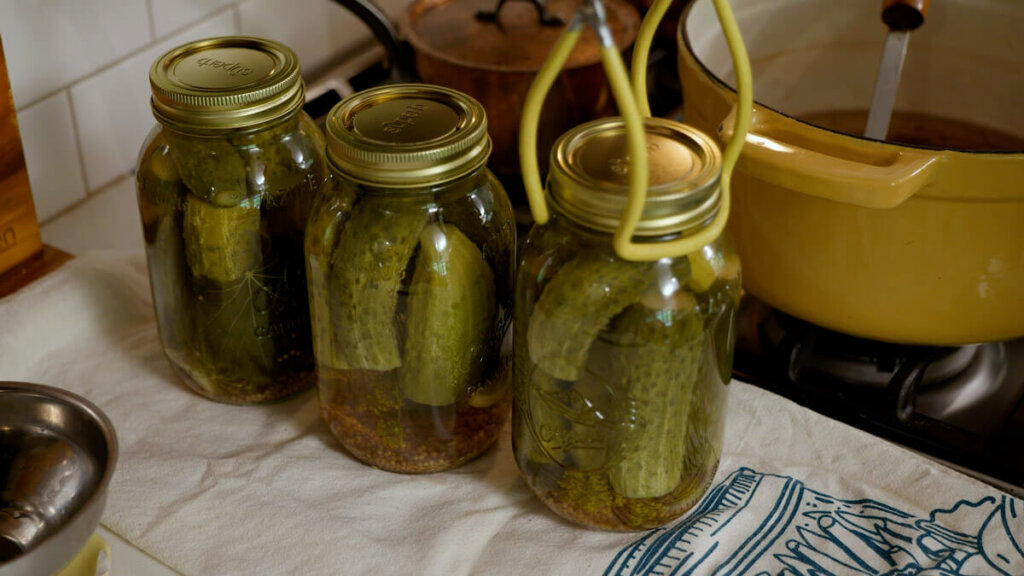
Did you make this recipe? If so, please leave a star rating in the recipe card below, then snap a photo of your crunchy pickles and tag me on social media @melissaknorris so I can see!
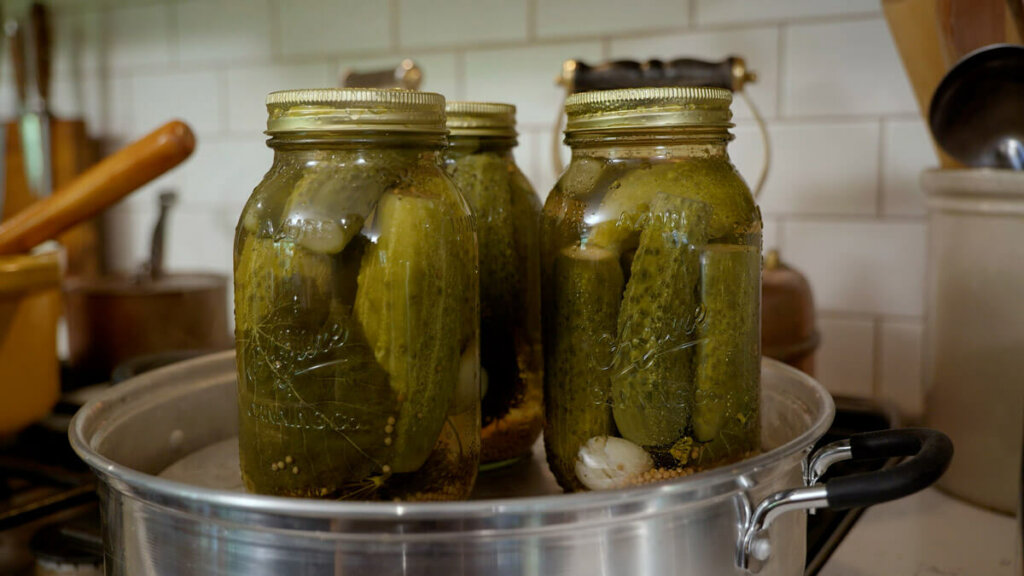
How Long Will Canned Pickles Last?
It’s true that for the best nutritional value, home-canned food should be consumed within a year. That’s why we try as hard as we can to plan and keep records to grow and preserve enough food for our family for a year.
However, one year our cucumber harvest was off the charts, and we canned up enough pickles to last us two years. They were still super crunchy after sitting on the pantry shelf for two years. (Watch the video to hear the crunch!)
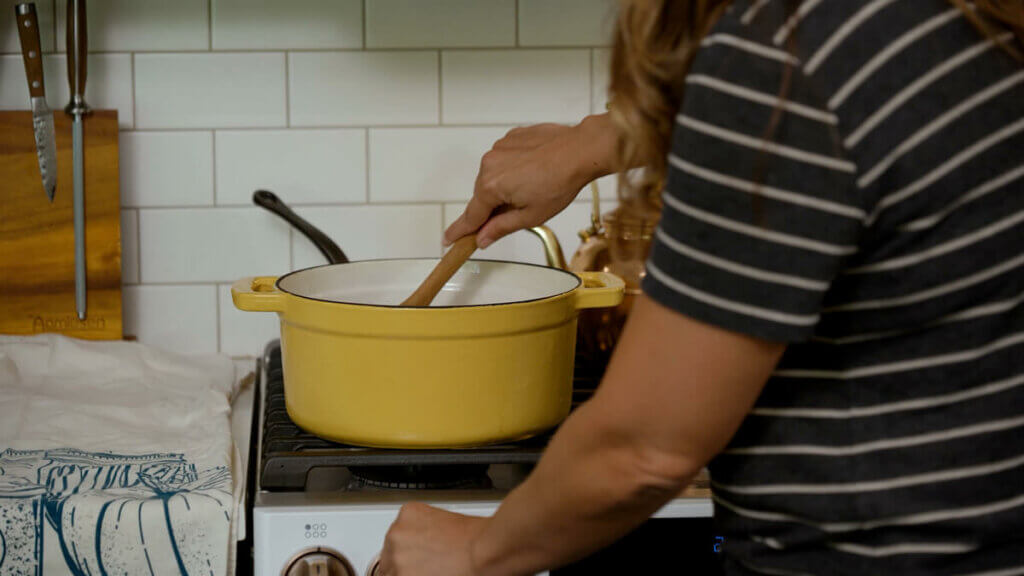
Pickle Making Tips & Tricks
- If you find yourself with leftover brine, you can let it cool down and store it in a jar until you’re ready to make your next batch of pickles. I like to make up large batches at a time and keep it in the refrigerator so I can whip up a batch of pickles anytime the harvest demands!
- Always make enough brine for each batch of pickles. If you run out of brine, DO NOT just top your jars off with water. This will change the acidity level and, therefore, the safety of your pickles.
- You can use the leftover brine to make sliced cucumber “quick pickles” as well. Just slice your cucumbers and top them with the brine, then let them sit overnight in the refrigerator (the flavor will continue to improve and is best after about two weeks).
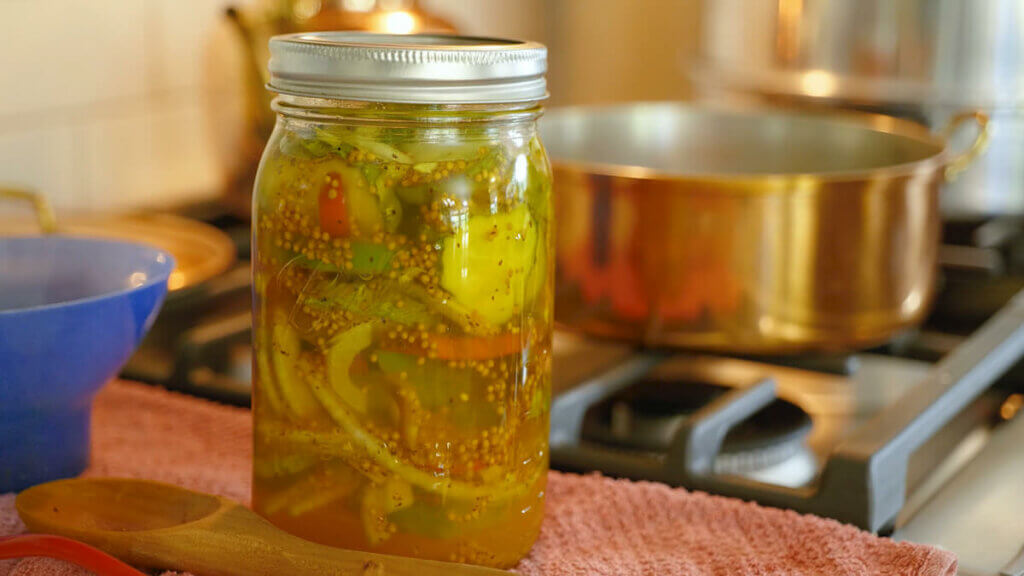
More Posts You Might Enjoy
- The Science of Home Food Preservation
- 129+ Best Canning Recipes to Put Up This Year
- Pickled Asparagus Recipe (Canned, Quick, or Refrigerator)
- Off Grid Living: What You Need to Know
- How Do You Know If A Canning Recipe Is Safe
- How to Pick the Best Preserving Methods
- Home Food Preservation- Preserving Plan for a Year’s Worth of Food
- Fermentation for Health Benefits & Food Preservation
- How to Can Green Beans the Easy Way
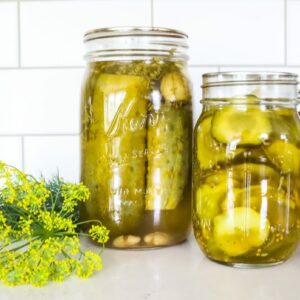
Best Homemade Pickles Recipe (Garlic Dill Pickles)
Equipment
- 1 Water Bath or Steam Canner
- 4 quart-sized canning jars with lids
Ingredients
For the Ice & Salt Water Soak
- ½ cup pickling salt
- 4 cups ice water to cover cucumbers
For the Brine
- 5 cups vinegar 5% vinegar
- 5 cups water
- 5 Tablespoons salt
- ¼ cup sugar optional
- 2 Tablespoon pickling spices see recipe in the notes
For the Pickles
- 7-8 pounds pickling cucumbers
- 8 cloves crushed garlic 2 cloves per quart jar
- 8 teaspoons mustard seed 2 teaspoons per quart jar
- 4 grape leaves 1 grape leaf per jar.
- 8-12 heads fresh dill 2-3 heads per quart jar (or 2 Tbs dried dill seed, or chopped dill weed)
Instructions
Prepare Cucumbers
- Prepare your cucumbers by cutting off ¼ inch of the blossom end and placing them in a salt and ice water bath for at least 12 hours.
Make Brine
- While your cucumbers soak, add all brining ingredients (vinegar, water, salt, sugar and pickling spices) into a large heavy-bottomed pot. Pro Tip: Use a tea infuser for your pickling spices so you don't have to strain the brine!
- Bring the brine mixture to a simmer and let steep for 10 minutes.
For the Pickles
- Before preparing the pickles, set up your water bath or steam canner by adding water and bringing it up to just under a boil.
- Add to each clean Mason jar the garlic, mustard seed, grape leaf (or other tannin) and dill.
- Fill jars with cucumbers. Leave a generous one-inch headspace with the cucumbers. Pro Tip: I like to start with the largest cucumbers first, then fill in the gaps with smaller cucumbers.
- Place jars on a towel-lined counter and carefully ladle the hot brine into each jar, leaving ½ inch headspace.
- Use your jar de-bubbler and measure your headspace again, adding more brine if needed.
- Wipe the rim of the jar clean with a damp towel.
- Add the two-piece Mason jar lids and tighten to fingertip tight.
- Place jars into your water bath canner and make sure they're covered by one to two inches of water. Bring water to a boil and process quart jars for 15 minutes and pints for 10 minutes. Pro Tip: If you're 1,000 feet above sea level, increase processing time by 5 minutes.
- After the processing time, turn off the heat and remove the lid of your water bath canner. Let your jars sit for five minutes before removing them from the canner. (If using a steam canner, turn off the heat and leave the lid on for five minutes before removing the lid and proceeding to the next step.)
- Place jars on a towel-lined counter and let sit for 12-24 hours, undisturbed.
- Check the seals of the jars, remove the bands, and wipe any residue from the jar with a damp towel.
- Finally, label each jar with the contents and the date and store in a single layer on the pantry shelf.
Notes
- 1 Tablespoon celery seed
- ½ Tablespoon whole black peppercorns
- ½ Tablespoon allspice
- Pick cucumbers in the morning. Cucumbers will be their firmest in the early morning. Try to avoid harvesting cucumbers in the afternoon when their water content is the lowest.
- Pick cucumbers when they’re ripe. If your cucumbers grow too large, they can get bitter or have off flavors. Plus, they’ll be hard to fit into the jar, or you’ll only be able to fit a couple of cucumbers per jar. Pick cucumbers when they still have their prickly spines and are light to dark green in color. A cucumber is over-ripe when it turns pale yellow, loses its spines and gets bloated.
- Use a good pickling variety of cucumbers. There are countless varieties of cucumbers available to grow in the garden, but not all cucumbers make good pickling cucumbers. Choose a variety that’s known for pickling (more on this below).
- Preserve them as soon as possible after harvesting. If you harvest cucumbers and let them sit at room temperature, they tend to get soft. Once a cucumber has gone soft, it won’t ever firm up again. So get cucumbers straight into the refrigerator after harvesting if you don’t have enough for a batch of pickles.
- Remove the blossom end. The blossom end contains enzymes that can cause soggy pickles. If the stem and blossom are both already removed and you’re not sure which end is the blossom end, look for the end that’s lighter green (watch the video for an example).
- Use an ice water/salt-water bath prior to canning. The ice water and salt help keep the pickles firm. The salt will actually help draw out excess moisture in the cucumber, which will result in a crispier pickle. You can soak cucumbers for up to three days in the refrigerator and keep adding more as you harvest. Allow them to soak for a minimum of 12 hours.
- Can the cucumbers in their whole form. I love a good pickle spear or sliced pickle, however I’ve noticed that my pickles will stay much more crisp when canned in their whole form. So if I want pickles spears or slices, I’ll just slice it at the time of eating.
- Add tannins! Tannins will also help keep pickles crunchy during the canning process (grape leaves are used in the recipe above, other options are listed in the article under ingredients needed section).

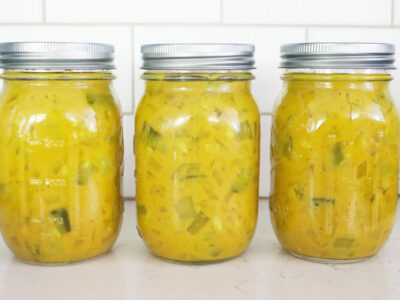
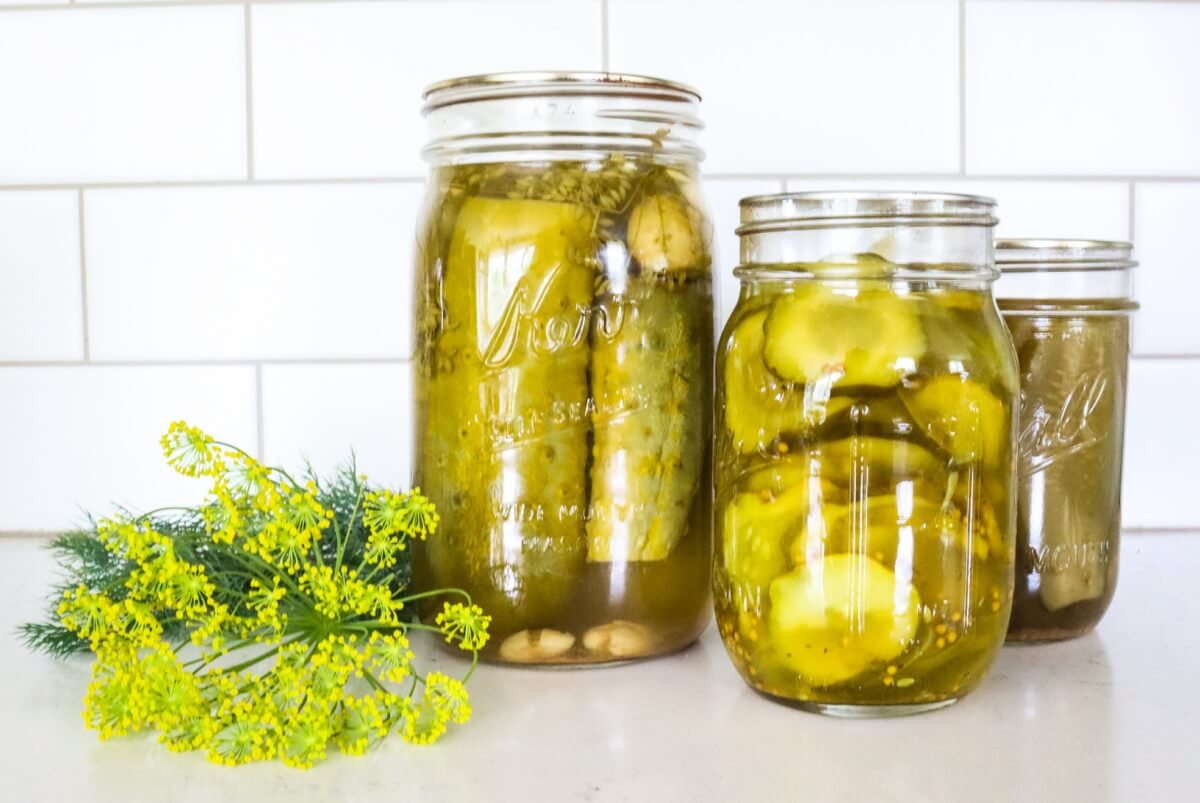
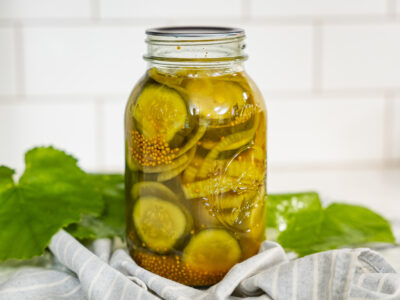
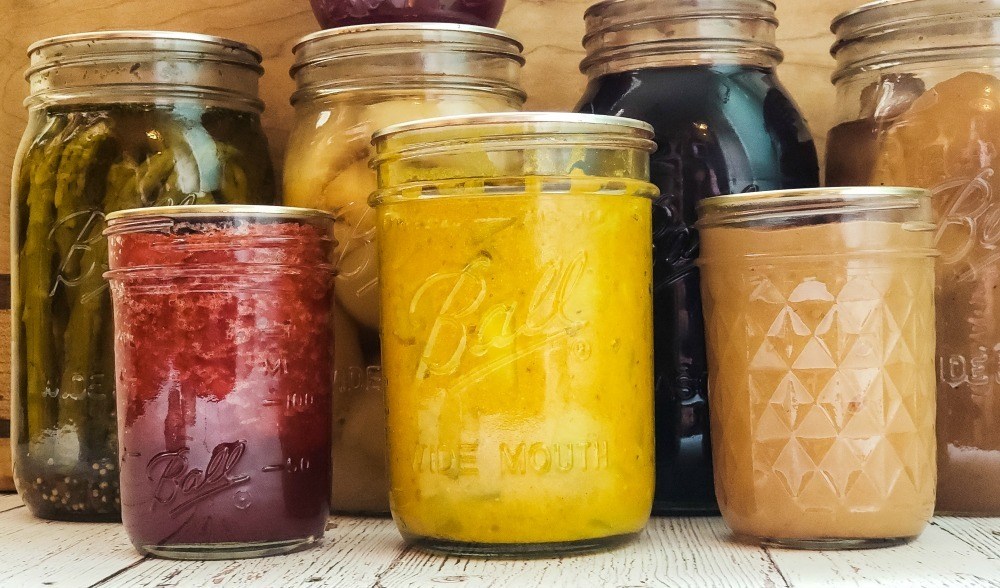
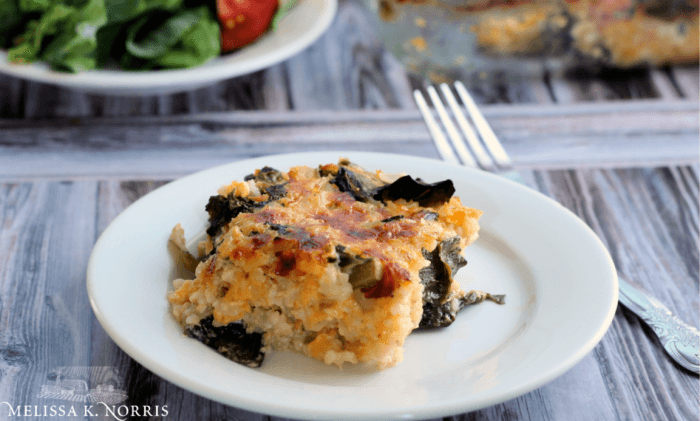
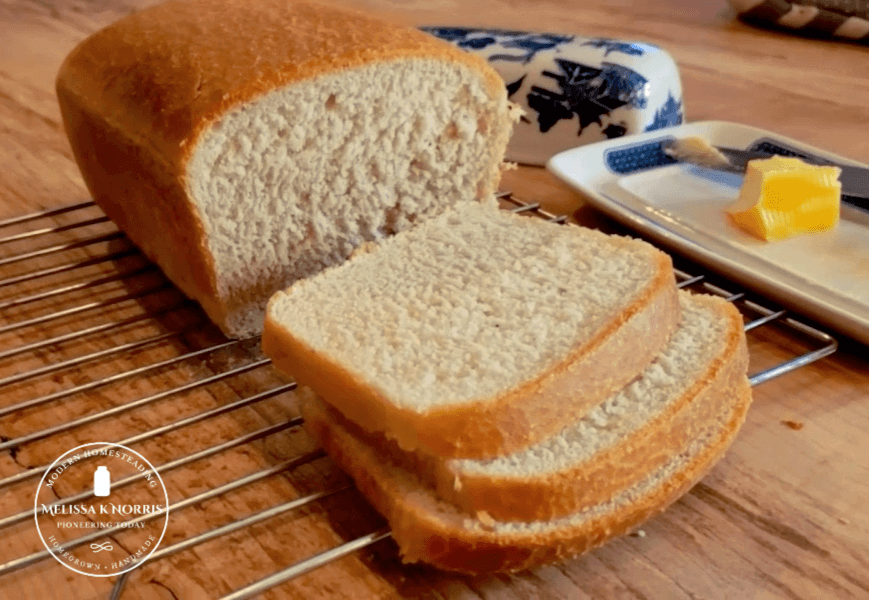
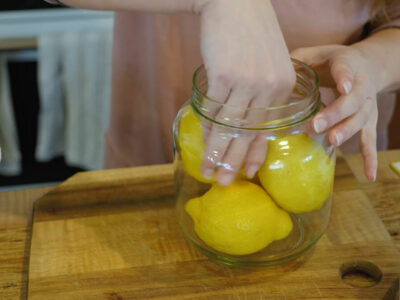
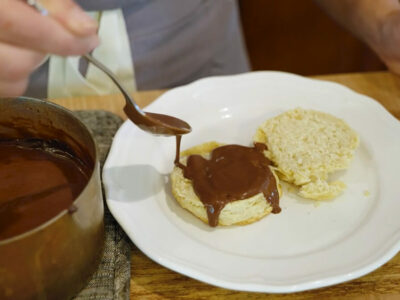
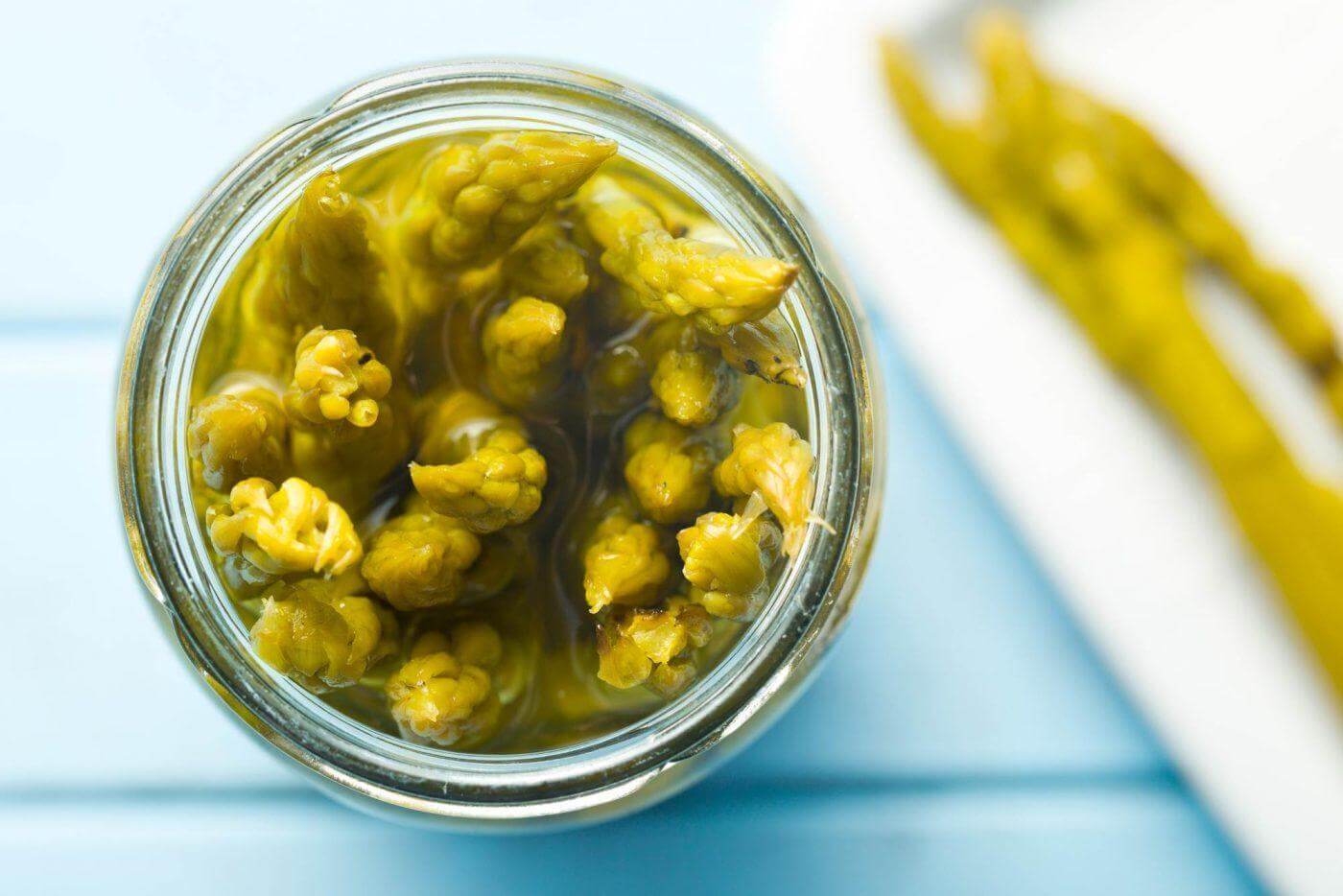

Can you use grape leaves picked from your yard?
yes
Is there added time for elevation change? I did not see anything
How would this recipe change if using a digital pressure canner? I will do my water bath canner this time but I would love tobuse my digital canner if possible!
How long do we need to wait to eat these after the 12-24 hr undisturbed time? My mother in law and I made these last night and I’d love to try them!
They’re best flavor if you can wait a week or two.
These have the best flavor and are crunchy even a year later
Hi Melissa, I’m trying your recipe for the first time and am excited to see the results. I made the mistake of not planting the pickling variety of cucumber, but, oh well, we will see how they turn out since I have such a huge harvest. I hate to throw away the bold water/salt water bath after just one use since I used a somewhat expensive salt (Redmond) so I am wondering if it can be reused and if so about how many times? I know you say pickles can be added if I initially didn’t have enough for a batch in one picking so it seems like it would be safe to use the water bath again. Thank you for your help.
Do you mean the brine that’s poured over the cucumbers? The water in the canner during processing shouldn’t have salt in it, I’m a little unsure of which water you’re referring to.
I interpreted the question as referring to the cold water brine you soak the cucumbers in prior to canning–like is that water safe to reuse for prepping multiple batches of cucumbers?
Picuki is a powerful software for these who value privateness, allowing users to browse Instagram anonymously.
Are you aware of ‘YouTubeMoa’?
Immerse yourself in a territory where top-notch topic comes together, thanks to high-tech methods.
A vast taciturnity of online wonders is at your disposal, selected from the boundless digital
department, to feed you in the know.
Connect with the enormous multitude who’ve significant their
hubspot in the direction of all things chic.
Go on increase ‘YouTubeMoa’ to your favorites and ever after halt
updated.
Your chatty favorite piece? One a stopcock separates you!
I just finished using this recipe and discovered an inconsistency: Equipment needed: 3 quart jars. Ingredients: 8 cloves of garlic (2 cloves per quart), 4 grape leaves (1 leaf per jar)…..which would indicate the recipe makes 4 quarts. I increased the brine ingredients proportionately for 4 quarts and had a LOT leftover. Can you please clarify. Is the recipe intended to make 4 quarts? Thanks
Can I add alum?
Hi Melissa, any tips for where to buy grape leaves? I’ve only noticed ones that have been canned in the grocery store. Thank you!
You can find grape vines growing wild just about anywhere. Stay away from freeways or heavily tragic road. As neighbor may be growing grapes too. ? also you can use fresh oak leave too.
Can we go without the grape leaves?
Yes
Did you have a link to the %of vinegar (how to dilute if using Azure 11%vinegar)?
How long do I need to wait before opening and eating a jar?!
I just opened one after 24 hours from processing and they were pretty good cooled but I think if I wait a bit longer they will taste better
My husband has dietary restrictions (sodium) Could I cut back on the amount of salt used?
hiiiiiiiiiiiiiiiiiiiiiiiiiiiiiiiiiiiiiiiiiii
Will only fresh grape leaves work? I only have jarred here in Texas.
Is there a reason for pouring hot brine on cucumbers? Would it be better to let cool so I’m not cooking/softening my pickles?
Actually this is for MELISSA – Is the sodium seriously “Sodium: 3054mg” per pickle? Is there anyway to lower that amount?
The nutritional guide lines aren’t correct, the software uses all ingredients and divides it but each cucumber doesn’t absorb the salt that is in the brine.
Melissa, can I use earl grey black tea for tannins? It’s all I have but will it alter flavor? Please help
It will infuse the brine with the flavor of the tea.
Hi, I’m about to try this recipe for the first time! Once the jars have sat on the counter for 12-24 hrs, can on of the jars go straight to the fridge? How long must they stay in the pantry or the fridge before eating?
I was wondering the same thing! Made them yesterday!
Hi Melissa. Do you prefer fermented pickles or this recipe. I’ve been using your fermented pickle recipe and love them. I still have some in my refrigerator from last July
I like both, I only have so much space in my fridge for fermented so I also can these for later in the year.
How long should I wait before opening a jar of your pickles?
Melissa, will any grape leaf do? I have muscadine grape vines everywhere.
Yes any grape leaf will work.
My kids like the pickles I make with Apple cider vinegar, than white vinegar.
What are the tannins that can be used?
It’s listed in the ingredients portion of the article.
I also was wondering about the tannins….in the ingredient list which are the tannins?
In the body of the article it says ingredients needed (not the printable recipe card as we can only fit so much on that card) it literally lists out the exact tannin options and amounts.
So strange because I read the recipe four times thinking I must be missing something. I haven’t clicked anything except the link to get here, and I don’t read the word “tannins” in the ingredients list. There is a place later that says tannins but says to see recipe below (but the recipe is above, so idk). Is it the grape leaves?
Grape leaves are the tannin listed in the recipe, I also listed other sources of tannins and amounts in the ingredients needed section.
Can this recipe be used as refrigerator pickles? With no hot water bath?
The grape leaf
Grape Leaves (or Black Tea) – The tannins found in grape leaves, black tea, oak leaves or horseradish leaves will help keep the pickles crunchy (some people use bay leaves, though this may add a unique flavor to your pickles). Add one leaf per jar, or add 4 teaspoons of loose leaf black tea to your brine (strain before filling jars).
My apologies! Thank you! I read that Bay leaves could possibly be substituted. What are your thoughts about that?
I haven’t tried it with bay leaves to know how I’d like the flavor.
Best pickle recipe EVER!!!
I loved this recipe. Seems to be the best way of making Homemade Pickles. We love to see more posts like this. So we can try this in future. Keep Post like this. Thank you
The promised list of tannins was no where to be found. Can you please provide a list to use with pickles? Thank you.
It’s listed in the ingredients used portion of the article.
Go back to beginning of article where it says grape leafs , if you can’t find them or choose to use , black tea leaf, oak leaf or horseradish leaf. It is confusing because it says see below and there is no below .
Dear Melissa, can I use this recipe for the pickles & just refrigerator them? ( I don’t know how to can yet). Thank you.
Yes, they’re great that way too!
Read the whole article there is a list of ingredients to use as tannins! It is difficult when folks speed read and then keep asking the same question over and over… here’s the link:
https://melissaknorris.com/best-homemade-pickles-recipe/
What is your ratio of vinegar to water? And when do you add it in? Thanks!